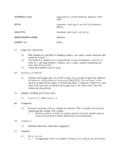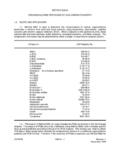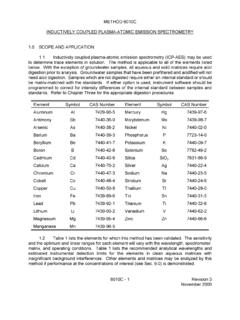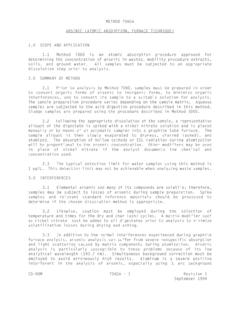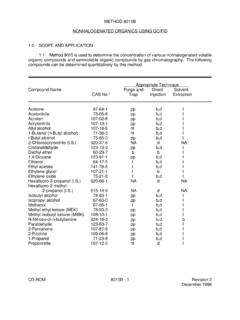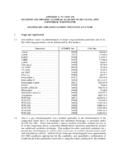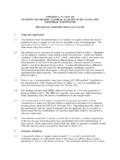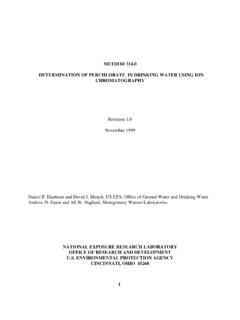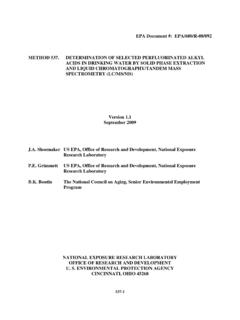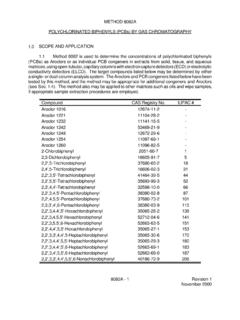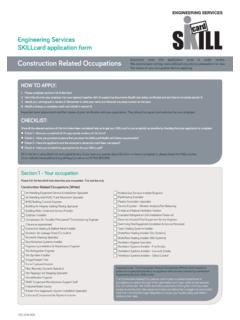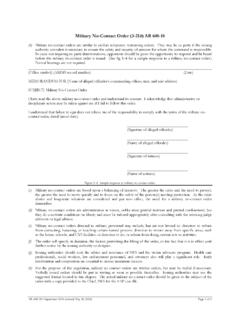Transcription of TITLE: ANALYTE: INSTRUMENTATION: IC - CAS Lab
1 METHOD #: for Approval for NPDES (August, 1991) TITLE: Determination Of Dissolved Hexavalent Chromium In DrinkingWater, Groundwater And Industrial Wastewater Effluents ByIon ChromatographyANALYTE:CAS # Chromium 7440-47-3, and method provides procedures for the determinatbn of dissolved hexavalentchromium in drinking water, groundwater and industrial wastewater Method Detection Limits (MDL, defined in Sectin 3) for the above matricesare listed in Table 1. The MDL obtained by an individual laboratory for aspecific matrix may differ from those listed depending on the nature of thesample and the instrumentation containing high levels of anionic species such as suHate and chloridemay cause column overload. Samples containing high levels of organics orsulfides cause rapid reduction of soluble Cr(VI) toCr(III). Samples must bestored at 4 C and analyzed within twenty-four hours of method should be used by analysts experienced in the use of ionchromatography and the interpretatbn of ion of aqueous sample is filtered through a um filter and the filtrate isadjusted to a pH of 9 to with a buffer solution.
2 A measured volume of thesample (50-250 L) is introduced into the ion chromatograph. A guard columnremoves organics from the sample before the Cr(VI) as CrO42-is separated onan anion exchange separator column. Post-Column derivatization of the Cr(VI)with diphenylcarbazide is followed by detection of the colored complex a that will pass through a um membrane Detection Limit (MDL)- The minimum concentration of an analyte thatcan be identified, measured and reported with 99% confidence that the analyteconcentration is greater than zero and determined from analysis of a sample ina given matrix containing analyte (1). Dynamic Range- The concentratbn range over which the analyticalworking curve remains Reagent Blank (LRB)- An aliquot of reagent water that is treatedexactly like a sample including exposure to all glassware, equipment, solventsand reagents that are used with samples. The LRB is used to determine if themethod analyte is present in the laboratory environment, the reagents Standard Solution- A concentrated, certified standard solution of themethod analyte .
3 The stock standard solution is used to prepare Standard (CAL)- A solution prepared from the stock standard andused to calibrate the instrument response with respect to analyte FonHied Blank (LFB)- An aliquot of reagent water to which aknown quantity of method analyte is added in the laboratory. The LFB isanalyzed exactly like a sample, and its purpose is to determine whether themethod is within accepted control Fortified Sample Matrix (LFM)- An aliquot of an environmentalsample to which a known quantity of method analyte is added in thelaboratory. The LFM is analyzed exactly like a sample, and its purpose is todetermine whether the sample matrix contributes bias to the analytical background concentration of the analyte in the sample matrix must bedetermined in a separate aliquot and the measured value in the LFM correctedfor the concentration Control Sample (QCS)- A solution containing a known concentration ofanalyte prepared by a laboratory other than the laboratory performing theanalysis.
4 The sample is used to check laboratory Duplicates (LD)- Two albuots of the same sample that ara treatedexactly the same throughout preparative and analytical procedures. Analysesof laboratory duplicates indicate precision associated with Performance Check Standards (LPC)- A solution of the analyteprepared in the laboratory by making appropriate dilutions of the stockstandard in reagent water. The LPC is used to evaluate the performance of theinstrument system within a given calibration which affect the accurate determination of Cr(VI) may come fromseveral A trace amount of Cr is sometimes found in reagentgrade salts. Since a concentrated buffer solution is used in this methodto adjust the pH of samples, reagent blanks should be analyzed toassess for potential Cr(VI) contamination. Contamination can also comefrom improperly cleaned glassware or contact of caustic or acidicreagents or samples with stainless steel or pigmented of soluble Cr(III) to Cr(VI) can occur in an alkaline mediumin the presence of oxidants such as Fe(III) and oxidized Mn or as aresult of the aeration that occurs in most extraction procedures (2-5).
5 Of Cr(VI) to Cr(III) can occur in the presence of reducingspecies in an acidic medium. At a pH of or greater, however,HCrO4-1is converted to CrO42-which is less reactive than the of the analytical column capacity with high concentrationsof anionic species, especially chloride and sulfate, will cause a loss ofCr(VI). The column specified in this method can handle samplescontaining up to 5% sodium sulfate or 2% sodium chloride (6). Poorrecoveries from fortified samples and tailing peaks are typicalmanifestations of column chromium is toxic and a suspected carcinogen and should behandled with appropriate precautbns (3,4). Extreme care should be exercisedwhen weighing the salt for preparation of the stock standard. Each laboratoryis responsible for maintaining a current awareness file of OSHA regulationsregarding the safe handling of chemicals specified in this method. A referencefile of material safety data sheets should also be available to all personnelinvolved in the chemical analysis (7,8).
6 And equipped with a pump capable of withstanding a minimumbackpressure of 2000 psi and capable of delivering a constant flow inthe range of 1-5 mL/min and containing no metal parts in the sample,eluent or reagent flow gas supply (high purity, ). eluent container, plastic, one or two liter loops of various sizes (50-250 L). pressurized reagent delivery module with a mixing tee and beadedmixing Column- A column placed before the separator columncontaining a sorbent capable of removing strongly absorbing organicsand particles that would otherwise damage the separator column(Dionex IonPac NG1 or equivalent). Column- A column packed with a high capacity anionexchange resin capable of resolving CrO42-from other sampleconstituents (Dionex IonPac AS7 or equivalent). low-volume flow-through cell visible lamp detector containing nometal parts in contact with the eluent flow path. Detection wavelengthis at 530 , integrator or computer for receiving analog or digital signalsfor recording detector response (peak height or area) as a function All reusable glassware (glass, quartz, polyethylene, Teflon, etc.)
7 Including the sample containers should be soaked overnight in laboratorygrade detergent and water, rinsed with water, and soaked for four hours in amixture of dilute nitric and hydrochloric acid (1+2+9) followed by rinsing withtap water and ASTM Type I : chromic acid must not be used for the cleaning of Class A volumetric flasks and a graduated Class A calibrated mL male luer-bck disposable m syringe bottle--high density polypropylene, 1 liter Processing sample transport containers- high density polypropylene,125 mL of dry ice or refrigerant packing and styrofoam meter- to read pH range 0-14 with accuracy um filter discs, cm diameter (Gelman Acro 50A, or equivalent) syringe filtration unit (Baxter Scientific, Cat. No. 1240 INor equivalent). and Consumable All chemicals are ACS grade unless otherwise hydroxide, NH4OH, ( ), (CAS RN 1336-21-6). sulfate, NH2SO4, (CAS RN 7783-20-2).
8 ,5 Diphenylcarbazide, (CAS RN 1 40-22-7). , HPLC acid, concentrated ( ). For all sample preparations and dilutions, ASTM Type I water (ASTMD1193) is required. Suitable water may be obtained by passing distilled waterthrough a mixed bed of anion and cation exchange (VI) Stock Solution- Dissolve 4,501 g of Na2 CrO4*4H2O in ASTM Type Iwater and dilute to one liter. Transfer to a polypropylene storage Reagent Blank (LRB)- Aqueous LRBs can be prepared by adjustingthe pH of ASTM Type I water to with the same volume of buffer as wasused for the Fortified Blank (LFB)- To an aliquot of reagent blank add analiquot of stock standard to produce a final concentration of 100 g/L ofCr(VI). The LFB must be carried through the entire sample preparation andanalysis Control Sample (QCS)- A quality control sample must be obtainedfrom an outside laboratory. Dilute an aliquot according to instructions andanalyze with Dissolve 33 g of ammonium sulfate in 500 mL of ASTM Type I waterand add mL of ammonium hydroxide.
9 Dilute to one liter with ASTM TypeI Reagent- Dissolve g of 1,5 diphenylcarbazide in 100 mL ofHPLC grade methanol. Add to about 500 mL of ASTM Type I watercontaining 28 mL of 98% sulfuric acid while stirring. Dilute with ASTM Type Iwater to one liter in a volumetric flask. Reagent is stable for four or five daysbut should only be prepared in one liter quantities as Solution- Dissolve 33 g of ammonium sulfate in 75 mL of ASTM Type Iwater and add mL of ammonium hydroxide. Dilute to 100 mL with ASTMType I Collection, Preservation and to the collection of the sample, consideration should be given to the typeof data required so that appropriate preservation and pretreatment steps canbe taken. Filtration and pH adjustment should be performed at the time ofsample collection or as soon thereafter as practically the determination of dissolved Cr(VI), the sample should be filteredthrough a um filter. Use a portion of the sample to rinse the syringefiltration unit and filter and then collect the required volume of filtrate.
10 Adjustthe pH of the sample to by adding dropwise a solution of the buffer,periodically checking the pH with the pH meter. Approximately 10 mLs ofsample are sufficient for three IC and store the samples at 4 C. Bring to ambient temperature prior toanalysis. Samples should be analyzed within twenty-four hours of At the time samples are analyzed a calibration should beperformed using a minimum of three calibration solutbns that bracket theanticipated concentratbn range of the samples. Calibration standards should beprepared from the stock standard (Sectbn ) by appropriate dilution withASTM Type I water (Sectbn ) in volumetric flasks. The solution should beadjusted to a pH of with the buffer solution (Section ) prior to Establish ion chromatographic operating conditions as indicated inTable 2. The flow rate of the eluent pump is set at mL/min and thepressure of the reagent delivery module adjusted so that the final flowrate from the detector is mL/min.
